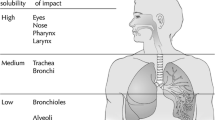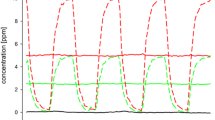Abstract
Irritation from the eyes and nose, termed sensory irritation, is the effect mediated by the trigeminal nerves. The effect is quantified by psychophysical methods, by electrophysiological methods or from the reflexively induced effect. The first step in the generation of the irritation response occurs due to interaction between an airborne substance and a protein receptor in the nerve. The classical receptor theory and the tools known from medicinal chemistry can therefore be applied also to the sensory irritation processes. The “linear free energy models” and the “thermodynamic activity” concepts are discussed in depth. Both these methods, if combined with rational test strategies, offer the possibility, in a cost-efficient manner, to give estirnates on effects of nontested substances. The basic biological knowledge on sensory irritation is far behind the knowledge on the exposure concentrations in the indoor environment. This seriously limits the possibility of interpreting the chemical measurements.
Access this chapter
Tax calculation will be finalised at checkout
Purchases are for personal use only
Preview
Unable to display preview. Download preview PDF.
Similar content being viewed by others
References
Abraham, M.H., Whiting, G.S., Alarie, Y., Morris, JJ., Taylor, PJ., Doherty, R.M., Taft, R.W. and Nielsen, G.D. (1990) “Hydrogen bonding 12. A new QSAR for upper respiratory tract irritation by airbome chemicals in mice” Quant. Struct.-Act. Relat. 9, 6–10.
Alarie, Y. (1973a) “Sensory irritation by airborne chemicals” CRC Crit. Rev. Toxicol. 2, 299–363.
Alarie, Y. (1973b) “Sensory irritation of the upper airways by airborne chemicals” Toxicol. Appl. Pharmacol. 24, 279–297.
ASTM (1984) “Standard test method for estimating sensory irritancy of airborne chemicals” designation: E 981-84, American Society for Testing and Materials, Philadelphia.
Brink, F.G. van den (1977) “General theory of drug-receptor interactions. Drug-receptor interaction models. Calculation of drug parameters” in J.M. van Rossum (ed.) Kinetics of Drug Action, Springer-Verlag, Berlin, pp. 169–254.
Brink, F. and Postemak, J.M. (1948) “Thermodynamic analysis of the relative effectiveness of narcotics” J. Cell. Comp. Physiol. 32, 211–233.
Cain, W.S. (1990) “Perceptual characteristics of nasal irritation” in B.G. Green, J.R. Mason and M.R. Kare (eds.), Chemical Senses, Vol.2, Irritation, Marcel Dekker, New York, pp. 43–60.
Cometto-Murñiz, J.E. and Cain, W.S. (1990) “Thresholds for odor and nasal pungency” Physiol. Behav. 48, 719–725.
Cometto-Murñiz, J.E. and Cain, W.S. (1991) “Nasal pungency, odor, and eye irritation thresholds for homologous acetates” Pharmacol. Biochem. Behav. 39, 983–989.
Cometto-Muñiz, J.E. and Hernández, S.M. (1990) “Odorous and pungent attributes of mixed and unmixed odorants” Percept. Psychophys. 47, 391–399.
Doty, R.L., Brugger, W.E., Jurs, P.C., Omdoff, M.A., Snyder, P.J. and Lowry, L.D. (1978) “Intranasal trigeminal stimulation from odorous volatiles: psychometric responses from anosmic and normal humans” Physiol. Behav. 20, 175–185.
Ferguson, J. (1939) “The use of the chemical potentials as indices of toxicity” Proc. Roy. Soc. London Ser.B, 127, 387–404.
Finger, T.E., Getchell, M.L., Getchell, T.V. and Kinnamon, J.C. (1990) “Affector and effector functions of peptidergic innervations of the nasal cavity” in B.G. Green, J.R. Mason and M.R. Kare (eds.). Chemical Senses, Vol.2, Irritation, Marcel Dekker, New York, pp. 1–20.
Franke, R. (1984) “Theoretical Drug Design Methods” Elsevier, Amsterdam.
Hansch, C. and Leo, A. (1979) Substituent Constants för Correlation Analysis in Chemistry and Biology, John Wiley, New York.
Hansen, L.F., Nielsen, G.D., Tøttrup, J., Abildgaard, A., Jensen, O.F.D., Hansen, M.K. and Nielsen, O. (1991) “Biological determination of emission of irritants from paint and lacquer” Indoor Air. 1(2), 95–110.
Hine, J. and Mookerjee, P.K. (1975) “The intrinsic hydrophilic character of organic compounds. Correlations in terms of structural constributions” J. Org. Chem. 40, 292–298.
Kane, L.E. and Alarie, Y. (1977) “Sensory irritation to formaldehyde and acrolein during single and repeated exposures in mice” Am. Ind. Hyg. Assoc. J. 38, 509–522.
Kane, L.E. and Alarie, Y. (1978) “Evaluation of sensory irritation from acrolein-formaldehyde mixtures” Am. Ind. Hyg. Assoc. J. 39, 270–274.
Kenakin, T.P. (1987) Pharmacologic Analysis of Drug-Receptor Interaction, Raven Press, New York.
Kenakin, T.P. (1989) “Challenges for receptor theory as a tool for drug and drug receptor classification” Trends Pharmacol. Sci. 10, 18–22.
Kobal, G. and Hummel, T. (1990) “Brain responses to chemical stimulation of the trigeminal nerve in man”, in B.G. Green, J.R. Mason and M.R. Kare (eds.), Chemical Senses, Vol.2, Irritation, Marcel Dekker, New York, pp. 123–139.
Kristiansen, U., Hansen, L., Nielsen, G.D., and Holst, E. (1986) “Sensory irritation and pulmonary irritation of cumene and n-propanol: mechanisms of receptor activation and desensitization” Acta Pharmacol. Toxicol. 59, 60–72.
Kristiansen, U. and Nielsen, G.D. (1988) “Activation of the sensory irritant receptor by C7-C 11 n-alkanes” Arch. Toxicol. 61, 419–425.
Kristiansen, U., Vinggaard, A.M. and Nielsen, G.D. (1988) “The effects of n-butanol vapour on respiratory rate and tidal volume” Arch. Toxicol. 61, 229–236.
Muller, J. and Greff, G. (1984) “Recherche de relations entre toxicite de molecules d’interet industriel et proprietes physico-chimiques: test d’irritation des voies aeriennes superieures applique a quatre familles chimiques” Food Chem. Toxicol. 22, 661–664.
Mølhave, L. (1988) Indoor Climate and Health. Air Quality and Indoor Climate, Institute of Environmental and Occupational Medicine, University of Aarhus. [Thesis in Danish].
Mølhave, L. and Nielsen, G.D. (1992) “Interpretation and limitations of the concept “Total Volatile Organic Compounds” (TVOC) as an indicator of human responses to exposures of volatile organic compounds (VOC) in indoor air” Indoor Air, submitted.
Nielsen, G.D. (1991) “Mechanisms of activation of the sensory irritant receptor by airborne chemicals” CRC Crit. Rev. Toxicol. 21, 183–208.
Nielsen, G.D. and Alarie, Y. (1982) “Sensory initation, pulmonary initation, and respiratory stimulation by airborne benzene and alkylbenzenes: prediction of safe industrial exposure levels and correlation with their thermodynamic properties” Toxicol. Appl. Pharmacol. 65, 459–477.
Nielsen, G.D. and Alarie, Y. (1992) “Animal assays for upper airway irritation: screening of materials and structure-activity relations” Ann. NY Acad. Sci., in press.
Nielsen, G.D. and Bakbo, J. C. (1985) “Sensory irritating effects of allyl halides and a role for hydrogen bonding as a likely feature at the receptor site” Acta Pharmacol. Toxicol, 57, 106–116.
Nielsen, G.D., Bakbo, J.C. and Holst, E. (1984) “Sensory irritation and pulmonary irritation by airborne allyl acetate, allyl alcohol, and allyl ether compared to acrolein” Acta Pharmacol. Toxicol. 54, 292–298.
Nielsen, G.D., Kristiansen, U., Hansen, L.F. and Alarie, Y. (1988) “Irritation of the upper airways from mixtures of cumene and n-propanol. Mechanisms and their consequences for setting industrial exposure limits” Arch. Toxicol. 62, 209–215.
Nielsen, G.D., Thomsen, E.S. and Alarie, Y. (1990) “Sensory irritant receptor compartment properties” Acta Pharm. Nord. 2, 31–44.
Nielsen, G.D. and Vinggaard, A.M. (1988) “Sensory irritation and pulmonary irritation of C3-C7 n-alkylamines: mechanisms of receptor activation” Pharmacol. Toxicol. 63, 293–304.
Nielsen, G.D. and Yamagiwa, M. (1989) “Structure-activity relationships of airway irritating aliphatic amines. Receptor activation mechanisms and predicted industrial exposure limits” Chem. Biol. Interact. 71, 223–244.
Purcell, W.P., Bass, G.E. and Clayton, J.M. (1973) “Strategy of Dry Design: A guide to Biological Activity” John-Wiley, New York.
Roberts, D.W. (1986) “QSAR for upper-respiratory tract irritation” Chem. Biol. Interact. 57, 325–345
Silver, W.L. (1990) “Physiological factors in nasal trigeminal chemoreception” in B.G. Green, J.R. Mason and M.R. Kare (eds.). Chemical Senses, Vol. 2, Irritation,Marcel Dekker, New York, pp. 21–41.
Silver, W.L., Mason, J.R., Adams, M.A. and Smeraski, C.A. (1986) “Nasal trigeminal chemoreception: responses to n-aliphatic alcohols” Brain Res. 376, 221–229.
Silver, W.L. and Moulton, D.G. (1982) “Chemosensitivity of rat nasal trigeminal receptors” Physiol. Behav. 28, 927–931.
Tallarida, R.J. (1988) “Pharmacologic methods for identification of receptors” Life Sciences, 43, 2169–2176.
Tepper, J.S., Weiss, B. and Wood, R.W. (1985) “Alterations in behavior produced by inhaled ozone and ammonia” Fund. Appl. Toxicol. 5, 1110–1118.
Wood, R.W. (1979) “Behavioral evaluation of sensory irritation evoked by ammonia” Toxicol. Appl. Pharmacol. 50, 157–162.
Wood, R.W. (1981) “Determinants of irritant termination behavior” Toxicol. Appl. Pharmacol. 61, 260–268.
Author information
Authors and Affiliations
Editor information
Editors and Affiliations
Rights and permissions
Copyright information
© 1992 Springer Science+Business Media Dordrecht
About this chapter
Cite this chapter
Nielsen, G.D., Hansen, L.F., Alarie, Y. (1992). Irritation of the upper airways. Mechanisms and structure-activity relationships. In: Knöppel, H., Wolkoff, P. (eds) Chemical, Microbiological, Health and Comfort Aspects of Indoor Air Quality — State of the Art in SBS. Eurocourses: Chemical and Environmental Science, vol 4. Springer, Dordrecht. https://doi.org/10.1007/978-94-015-8088-5_8
Download citation
DOI: https://doi.org/10.1007/978-94-015-8088-5_8
Publisher Name: Springer, Dordrecht
Print ISBN: 978-90-481-4152-4
Online ISBN: 978-94-015-8088-5
eBook Packages: Springer Book Archive




